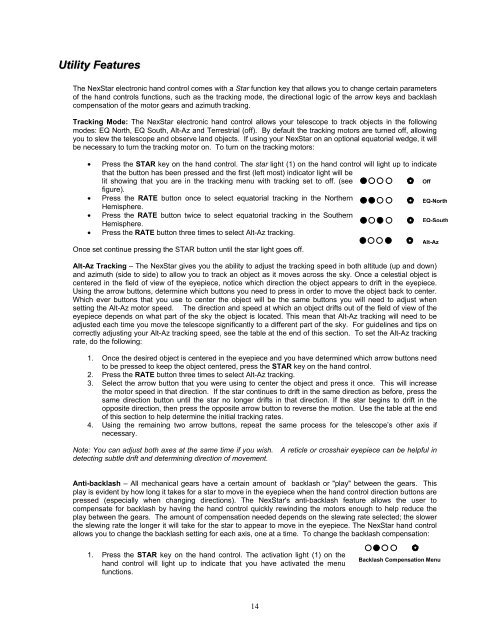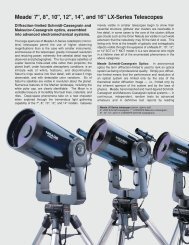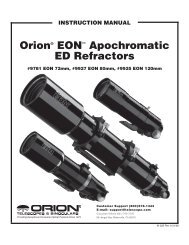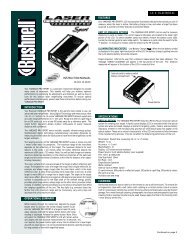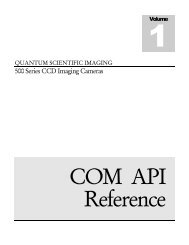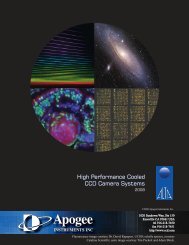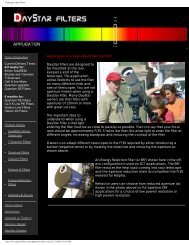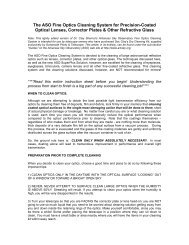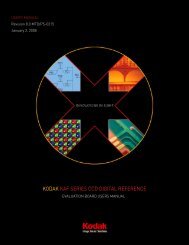INSTRUCTION MANUAL
INSTRUCTION MANUAL
INSTRUCTION MANUAL
You also want an ePaper? Increase the reach of your titles
YUMPU automatically turns print PDFs into web optimized ePapers that Google loves.
Utility Features<br />
The NexStar electronic hand control comes with a Star function key that allows you to change certain parameters<br />
of the hand controls functions, such as the tracking mode, the directional logic of the arrow keys and backlash<br />
compensation of the motor gears and azimuth tracking.<br />
Tracking Mode: The NexStar electronic hand control allows your telescope to track objects in the following<br />
modes: EQ North, EQ South, Alt-Az and Terrestrial (off). By default the tracking motors are turned off, allowing<br />
you to slew the telescope and observe land objects. If using your NexStar on an optional equatorial wedge, it will<br />
be necessary to turn the tracking motor on. To turn on the tracking motors:<br />
• Press the STAR key on the hand control. The star light (1) on the hand control will light up to indicate<br />
that the button has been pressed and the first (left most) indicator light will be<br />
lit showing that you are in the tracking menu with tracking set to off. (see<br />
Off<br />
figure).<br />
• Press the RATE button once to select equatorial tracking in the Northern<br />
Hemisphere.<br />
• Press the RATE button twice to select equatorial tracking in the Southern<br />
Hemisphere.<br />
• Press the RATE button three times to select Alt-Az tracking.<br />
Once set continue pressing the STAR button until the star light goes off.<br />
Alt-Az Tracking – The NexStar gives you the ability to adjust the tracking speed in both altitude (up and down)<br />
and azimuth (side to side) to allow you to track an object as it moves across the sky. Once a celestial object is<br />
centered in the field of view of the eyepiece, notice which direction the object appears to drift in the eyepiece.<br />
Using the arrow buttons, determine which buttons you need to press in order to move the object back to center.<br />
Which ever buttons that you use to center the object will be the same buttons you will need to adjust when<br />
setting the Alt-Az motor speed. The direction and speed at which an object drifts out of the field of view of the<br />
eyepiece depends on what part of the sky the object is located. This mean that Alt-Az tracking will need to be<br />
adjusted each time you move the telescope significantly to a different part of the sky. For guidelines and tips on<br />
correctly adjusting your Alt-Az tracking speed, see the table at the end of this section. To set the Alt-Az tracking<br />
rate, do the following:<br />
1. Once the desired object is centered in the eyepiece and you have determined which arrow buttons need<br />
to be pressed to keep the object centered, press the STAR key on the hand control.<br />
2. Press the RATE button three times to select Alt-Az tracking.<br />
3. Select the arrow button that you were using to center the object and press it once. This will increase<br />
the motor speed in that direction. If the star continues to drift in the same direction as before, press the<br />
same direction button until the star no longer drifts in that direction. If the star begins to drift in the<br />
opposite direction, then press the opposite arrow button to reverse the motion. Use the table at the end<br />
of this section to help determine the initial tracking rates.<br />
4. Using the remaining two arrow buttons, repeat the same process for the telescope’s other axis if<br />
necessary.<br />
Note: You can adjust both axes at the same time if you wish. A reticle or crosshair eyepiece can be helpful in<br />
detecting subtle drift and determining direction of movement.<br />
EQ-North<br />
EQ-South<br />
Alt-Az<br />
Anti-backlash – All mechanical gears have a certain amount of backlash or "play" between the gears. This<br />
play is evident by how long it takes for a star to move in the eyepiece when the hand control direction buttons are<br />
pressed (especially when changing directions). The NexStar's anti-backlash feature allows the user to<br />
compensate for backlash by having the hand control quickly rewinding the motors enough to help reduce the<br />
play between the gears. The amount of compensation needed depends on the slewing rate selected; the slower<br />
the slewing rate the longer it will take for the star to appear to move in the eyepiece. The NexStar hand control<br />
allows you to change the backlash setting for each axis, one at a time. To change the backlash compensation:<br />
1. Press the STAR key on the hand control. The activation light (1) on the<br />
hand control will light up to indicate that you have activated the menu<br />
functions.<br />
Backlash Compensation Menu<br />
14


